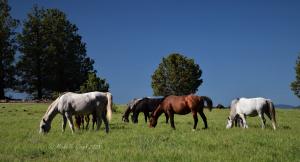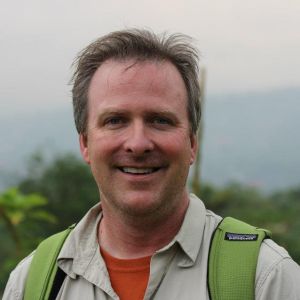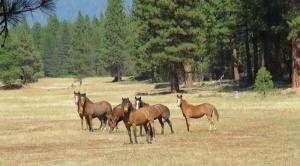Nonprofit Prevails Over Bureau of Land Management - Wins Settlement In Favor of Wild Horses

The genetic vigor of wild horses living in a balanced wilderness ecosystem is seen in the family of wild horses

Professor-Litigator, Michael R Harris J.D.
Vermont Law & Graduate School’s Environmental Advocacy Clinic prevailed in lawsuit against Bureau of Land Management on behalf of client Wild Horse Fire Brigade
YREKA, CA, USA, July 20, 2023/EINPresswire.com/ -- On Wednesday, October 5. 2022, the all-volunteer California-based 501-c-3 nonprofit Wild Horse Fire Brigade ('WHFB') filed a Federal lawsuit in the United States District Court For the District of Columbia (Case No. 22-3006).The lawsuit sought a halt to the roundup of wild horses from private property within and adjacent to the Pokegama Herd Management Area in southern Oregon. That legal filing (Case number, etc.) can also be seen in the attached images.
The Bureau of Land Management (BLM) had failed to follow the law and its own guidance before initiating the roundup.
The suit sought to prevent the loss of native wild horses that are valuable to the ecosystem and to compel BLM to conduct legally required studies regarding the horses.
A RARE WIN FOR WILD HORSES
On July 18, 2023, after months of legal jousting, the U.S. Department of Justice settled the lawsuit brought against the U.S. Bureau of Land Management ('BLM') by Vermont Law and its client Wild Horse Fire Brigade ('WHFB').
The BLM initiated the roundup in 2020, intending to capture 200 of the estimated 230 horses that live in Pokegama HMA. Before initiating a roundup, BLM is required to conduct an excess determination as required by the Free Roaming Wild Horse and Burro Act (WHBA), and conduct a review of the decision under the National Environmental Policy Act (NEPA). The BLM must also provide the public with reasonable notice and an opportunity to comment, as required by the Administrative Procedure Act (APA), BLM guidance applicable to decisions to remove wild horses from the range, and/or NEPA. As a result of the lawsuit and settlement, the roundup was halted and the BLM must now comply with the law in order to consider any future roundups, if any.
Michael Harris, legal advisor to Wild Horse Fire Brigade and Professor-litigator at Vermont Law had this to say about this victory for American wild horses; "The Environmental Advocacy Clinic was excited to partner with WHFB to protect the Pokegama wild horses. More importantly, we were able to put a stop to the illegal removal of horses by BLM, an agency that has persistently shown it has no interest in carrying out its legal mandate to protect these amazing creatures on public lands owned by all of us."
Wild Horse Fire Brigade Vice President Kelsey Stangebye offered this perspective; "I want to underscore how important this settlement is for the Pokegama Herd and the future of wild horses living wild and free on the range. There is no doubt in my mind that if the Wild Horse Fire Brigade did not file suit against the BLM based on the illegal roundup, then this herd would have been decimated and removed from the public range with no public attention nor knowledge. This settlement is a victory for the Pokegama Herd to continue to live wild in this herd management area."
"Too often we see wild horse advocates sue the Bureau of Land Management without success and use their lawsuits as a PR stunt to get more donations. As an all-volunteer board of a 501-c-3 nonprofit, we need every donation dollar to count for our mission to save wild horses. The synergy between the ‘pro bono’ efforts of Vermont Law School led by our board's legal advisor Michael Harris, and the compelling facts related to the Bureau of Land Management performing an illegal roundup of the Pokagama wild horses created a situation that supported bringing a legal action”, said Deb Ferns, President of Wild Horse Fire Brigade.
Chronic Genetic Mismanagement of native species American Wild Horses by the BLM:
Approximately 230 wild horses live in the 80,885-acre Pokegama Herd Management Area (HMA), located in a remote area near the California-Oregon border, southwest of Klamath Falls, OR. That's just one horse for every 352-acres.
The BLM's own Wild Horse and Burro Management Handbook specifies that in order to maintain 'genetic diversity' in a herd of wild horses, there must be a "total population size of about between 150-200 animals" in the herd. And this relatively low breeding population is allowable only if a studbook is maintained (note: the BLM does not have a studbook for this herd).
Quote from page 22 of the BLM's Wild Horse Management Handbook:
"4.4.6.3 Herd Size
A minimum population size of 50 effective breeding animals (i.e., a total population size of about 150-200 animals) is currently recommended to maintain an acceptable level of genetic diversity within reproducing WH&B populations (Cothran, 2009). This number is required to keep the rate of loss of genetic variation at 1 percent per generation." Here is a link to the BLM's Wild Horse and Burro Management Handbook:
Shockingly, the BLM's website for the Pokegama Herd Management Area (HMA) is in total conflict with their own population management guidance, claiming the 'appropriate population' (aka: AML) for the herd is just 30-50 horses! That's just one horse for every 1,600-acres.
This low population management number (AML 30-50 horses), if used, would according to the BLM's own Handbook guarantee inbreeding, loss of genetic diversity and ultimate herd failure, as further cited in published science, here: https://cmvnunez.weebly.com
An examination of many other Herd Management Areas (HMAs) managed by the BLM shows published population management levels (aka: AMLs) with population numbers well below what is scientifically required to maintain robust genetic vigor of American wild horses. Making matter even worse is the rampant use of chemical sterilants (PZP & GonaCon) by the BLM on mares in these low-population herds. The result of what is being called 'Fertility Control' is sterilized mares, which ends natural life-cycles, disrupts herd and family-band social dynamics and accelerates genetic erosion.
Here is the link to the BLM's Pokegama HMA page: https://www.blm.gov/programs/wild-horse-and-burro/herd-management/herd-management-areas/oregon-washington/pokegama
Wild horses have lived in the general area according to cultural archaeological records since 1580, when wild horses in this region were observed and documented as living among the indigenous peoples by the explorer Sir Francis Drake. More about Drake's observation here: https://pcrecordtimes.com/article/can-wild-horses-be-a-solution-instead-of-a-problem
More about native species wild horses here: https://www.einnews.com/pr_news/620446849/american-wild-horses-are-understudied-that-results-in-grossly-overlooked-ecological-benefits
These regional wild horses play an essential role in managing grassland and forest ecosystems by reducing and maintaining grass and shrubs that present a major wildfire hazard. Additionally, unlike invasive species ruminant livestock that have multi cambered stomachs and chew a cud (cattle, sheep and goats) that digest most of the plant and grass seeds they consume, which can ultimate strip a landscape of native flora, horses pass most of the seeds they consume intact and able to germinate in their dung, thereby reseeding the landscapes where they graze.
In fact, the herd of wild horses owned and managed by local rancher/researchers (William Simpson & Michelle Gough) in conjunction with Wild Horse Fire Brigade, were instrumental in aiding CALFIRE during the deadly 2018 Klamathon Fire via wildfire fuels reductions prior to the onset of the wildfire, by creating and maintaining areas of reduced grass and brush fuels.
Areas of reduced fuels are also known as 'fire-breaks' and 'safe-zones', which benefit firefighters. These fire-breaks and areas of reduced wildfire fuels make wildfire suppression efforts by firefighters more effective, a fact that is also supported by published science.
AM BEST, which provides analytical data to the insurance industry, having conducted some due diligence on wild horses engaged in wildfire grazing, produced a TV episode about 'Wild Horses and Wildfires', which can be seen online at this LINK:
https://sierranevadaally.org/2022/04/04/the-american-heritage-of-wild-horses/
About Vermont Law and Graduate School:
Vermont Law and Graduate School, a private, independent institution, is home to the nation’s premier environmental law program. The school features innovative experiential programs and is home to the Environmental Law Center, South Royalton Legal Clinic, Environmental Advocacy Clinic, Energy Clinic, Food, and Agriculture Clinic, Environmental Justice Clinic, and Center for Justice Reform.
For more information, visit vermontlaw.edu, find us on Facebook, and follow us on Twitter and Instagram.
About Wild Horse Fire Brigade:
Wild Horse Fire Brigade (WHFB) is a California-based 501-c-3 all-volunteer nonprofit public benefit corporation. WHFB is working to save native species American wild horses by rewilding them away from Bureau of Land Management holding facilities as well as relocating wild horses away from areas where they are deemed to be in conflict, and humanely reestablishing these American icons into ecologically and economically appropriate wilderness areas as keystone herbivores where they will reduce the frequency, size and intensity of catastrophic wildfire by reducing grass and brush wildfire fuels.
For more information visit: https://www.WildHorseFireBrigade.org
Find us on Facebook, and follow us on Twitter, Instagram.
Wild Horse Fire Brigade's YouTube channel has over 200 short educational & informational videos about wild horses.
HERE: https://www.youtube.com/@wildhorsefirebrigade2191/videos
William E. Simpson II
Wild Horse Fire Brigade
+1 858-212-5762
email us here
Visit us on social media:
Facebook
Twitter
Instagram
YouTube
Other
More Wild Horses Equals Less Wildfires
Legal Disclaimer:
EIN Presswire provides this news content "as is" without warranty of any kind. We do not accept any responsibility or liability for the accuracy, content, images, videos, licenses, completeness, legality, or reliability of the information contained in this article. If you have any complaints or copyright issues related to this article, kindly contact the author above.



